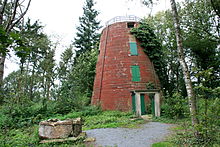Friedrich Hartmann (painter)
Friedrich Hartmann (born May 30, 1912 in Siegen , Westphalia , † December 15, 2000 in Gildehaus , Grafschaft Bentheim ) was a German painter .
life and work
Hartmann grew up in Mülheim / Ruhr , where he passed his Abitur and then studied architecture and painting at the Art Academy in Düsseldorf . After working as a lecturer at the Folkwang School in Essen for a few years , private contacts took him to the Grafschaft Bentheim , where he settled in Gildehaus in 1948. In the economically difficult post-war years it was difficult to find buyers for pictures, so that Hartmann exchanged many of his oil paintings on wood or chipboard for natural products and therefore liked to call the works "bacon pictures".
Hartmann set up a studio in the mill stump of the Westmühle in Gildehaus, which was set on fire in the last days of the Second World War and actually destined for demolition, called it Lukasmühle and lived there with his family of five for the first few years. He had the ruin provided with a flat roof, which he provided with a rain-repellent oil paint. On the outer wall he painted a larger than man picture of the evangelist Luke , who is considered the patron saint of painters and artists. Hartmann ran an open studio and lived as a freelance painter from selling his works.
Despite the breadth of his artistic activity, he developed his own style as a painter. He mainly created oil paintings and watercolors as well as pictures in stain or chalk , mostly earth-colored tones predominating and living on the special tension between light and darkness. He mixed his oil paints himself from earth and minerals. He was best known for a wood staining technique he developed. In addition to home motifs from the county of Bentheim, such as the Gildehauser Venn and Bentheim Castle , Frenswegen Abbey and the Lage Castle ruins or farms and landscape views, he picked up motifs from the Münsterland , East Frisia , Schleswig-Holstein , the Eifel or Lake Constance that he thought of encountered numerous trips. For many years he used to present his travel pictures on an Advent Sunday in the community center of the Evangelical Church in Gronau .
He was also interested in historical topics. Above all , he dedicated a number of works to the Staufer period with its royal palaces , castles and churches between Hohenstaufen and Apulia , Wimpfen and Sicily . In other pictures he implemented mystical , mythological and religious themes.
In addition to painting, he created a number of mosaic works and made a name for himself as a restorer of religious art and church painter. Church congregations of all denominations were his clients. His works include the rows of windows in the chapel of the former Marienkrankenhaus in Nordhorn , paintings in the cemetery chapel in Gildehaus and a large triptych in the Lutheran Christophorus Church in Schüttorf. Among the sculptures, the bronze cast of the Lord God of Bentheim , which is widespread in large numbers, and the almost head- high bronze candlesticks in the Evangelical Reformed church in Gildehaus or the memorial for the war dead in the cemetery in Emlichheim are to be mentioned.
Friedrich Hartmann Museum
Friedrich Hartmann had stipulated in his will that the Lukasmühle in the form he left with his studio and a collection of paintings from his artistic work should be preserved as a museum for the public. In 2001 the Friedrich-Hartmann-Museum was founded in the Lukasmühle eV , which has since run a museum in the Lukasmühle that shows more than 100 Hartmann's exhibits.
In addition, the association has set itself the goal of collecting and listing all works made by the artist. So far, around 1,600 works such as paintings, drawings, the design of sacred spaces or other works of art have been recorded in a catalog raisonné.
literature
- Heinrich Voort: Left a rich work in many places. On the death of the painter Friedrich Hartmann. Grafschafter Nachrichten of December 20, 2000.
- Rolf Krebs: In memoriam Friedrich Hartmann (1912-2000) . Bentheimer Jahrbuch 2002. ISBN 3-922428-61-4 .
Web links
Individual evidence
- ↑ Catalog of works ( Memento of the original from August 19, 2014 in the Internet Archive ) Info: The archive link was automatically inserted and not yet checked. Please check the original and archive link according to the instructions and then remove this notice.
| personal data | |
|---|---|
| SURNAME | Hartmann, Friedrich |
| BRIEF DESCRIPTION | German painter |
| DATE OF BIRTH | May 30, 1912 |
| PLACE OF BIRTH | Siegen , Westphalia |
| DATE OF DEATH | December 15, 2000 |
| Place of death | Gildehaus , Grafschaft Bentheim |

